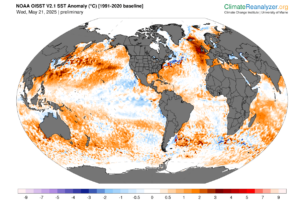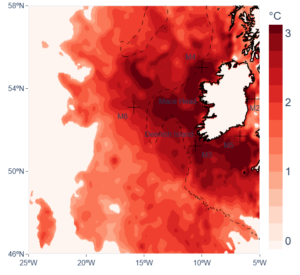High pressure and easterly winds are contributing to average monthly Sea Surface Temperatures (SSTs) around Irish coasts being between 0.6 and 2.2°C higher than average for this time of year.
Sea Surface Temperatures (SSTs) along Ireland’s western and southern coasts have been significantly above average throughout May 2025. Provisional observational data from the Irish Marine Data Buoy Observation Network (IMDBON), which is managed by the Marine Institute in collaboration with Met Éireann, show that SSTs have been rising steadily over the month.

Fig. 1 – Global sea-surface temperature anomaly map shows sea-surface temperatures off the west coast of Ireland significantly above the 1991-2020 baseline.
While marine heatwaves are occurring in various regions globally (Fig. 1), the particularly high anomalies in the eastern North Atlantic—off Ireland’s west coast—are striking. This localised warming is primarily due to a persistent high-pressure system that has dominated weather patterns over northwest Europe during spring. These conditions—clear skies, light winds, and warm easterly flows—have been especially conducive to rapid surface heating in this part of the ocean. Elsewhere, similar setups have not been as stationary or as intense, which helps explain why the anomaly is not mirrored across the broader Atlantic. The positioning and persistence of atmospheric patterns like these can create sharp regional contrasts, even against the backdrop of globally rising ocean temperatures. The anomalies are compared to the most recent 1991-2020 baseline, meaning they are not as pronounced as they would be when compared to an earlier, colder baseline.
As of mid-May, temperatures at several IMDBON buoys were already more than 1°C above the monthly average (Fig. 2). With a week remaining in the month, it is likely that the final monthly averages will be even higher.

Fig. 2 – IMDBON average sea surface temperatures for May so far (22nd May 2025)
This warming continues a trend observed recently. April 2025 saw record mean monthly SSTs at three of the five buoy locations:
- M4 recorded 11.32 °C (above the 2011 April record of 10.74°C).
- M2 reached 9.69 °C (surpassing the 2024 April record of 9.65 °C),
- M3 hit 11.99 °C (beating the previous April high of 11.91 °C from 2007),
- Based on current data, M3 is on track to break its May record as well (Fig. 3).
Met Éireann Climatologist Paul Moore says “The elevated SSTs are largely due to a persistent area of high pressure to the north of Ireland and the UK throughout spring. This pattern has brought clear skies, above-average sunshine, and reduced wind speeds. Easterly winds, which are not typical for this time of year, have contributed to rapid warming of surface waters off the west and south coasts by limiting ocean mixing and carrying warmer air from land out to sea.”

Fig. 3: Sea Surface Temperature Anomalies on 22 May 2025 (from the Marine Institute’s Marine Heatwave Monitoring Tool).
Similar meteorological conditions were present in May and June 2023, which preceded Ireland’s warmest June on record. Research has shown that marine heatwaves can reduce cloud cover over the sea and increase convective rainfall over land due to warmer, moister sea breezes. This reflects broader climate projections indicating that a warmer atmosphere can hold 7% more moisture per degree of warming, which can lead to more intense rainfall events.
Although this spring has so far been marked by dry weather due to the dominant high pressure, the unusually warm sea temperatures could contribute to increased rainfall intensity if atmospheric conditions change. A shift in the weather is expected in the coming days, with stronger westerly winds, coming from the Atlantic, forecast to return. These winds should help mix cooler subsurface water with the warm surface layer, potentially decreasing SSTs, at least temporarily. However, the ocean is a slow-moving thermal reservoir compared to the atmosphere, so cooling effects may take time to occur, likely not becoming evident until the end of the month.
Globally, rising ocean temperatures are a clear sign of climate change. As the atmosphere and oceans warm, the number and duration of marine heatwaves are projected to increase. These events can have major ecological impacts, including coral bleaching, shifts in marine species, harmful algal blooms, and disruptions to food chains. While recent marine heatwaves around Ireland have occurred outside the typical peak SST period in August, future events aligning with the warmest part of the year could place greater stress on marine ecosystems.
Notes to reader:
Listen to Met Éireann Climatologist Paul Moore on RTÉ radio explaining the May 2025 Marine Heatwave: https://www.rte.ie/radio/radio1/clips/22515270/
SST data from the IMDBON are recorded hourly and are closely monitored by the Marine Institute and Met Éireann. For more information and real-time marine heatwave data, visit:
https://www.marine.ie/site-area/data-services/remote-sensing/marine-heat-waves
June 2023 Marine Heatwave: Exceptional atmospheric conditions in June 2023 generated a northwest European marine heatwave which contributed to breaking land temperature records | Communications Earth & Environment
Marine Heatwaves and Climate Change: Marine Heat Wave 2023 – A Warning for the Future – Met Éireann – The Irish Meteorological Service